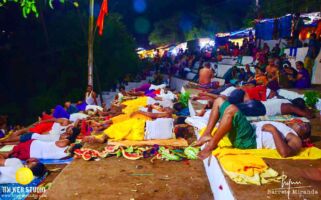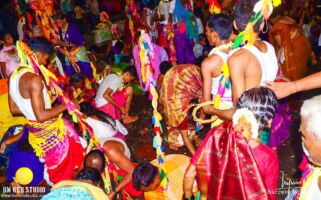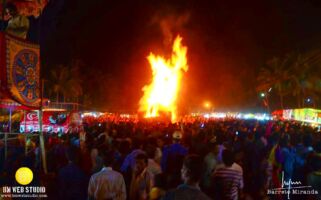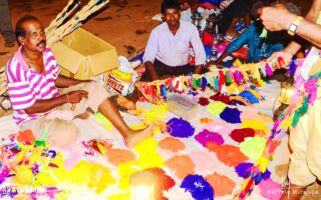Lairai Zatra in Shirgao
One of the most looked forward event in the Hindu Calendar of religious festivities is the fire walking held at Shirgao, near Assanora in the Bicholim Taluka.
This festival is in celebration of the deity Sri Lairaie. Though Sateri is the presiding deity of Shirgao, goddess Lairai gained popularity when it was brought to Shirgao. There are around 14 deities being worshipped in Shirgao. It is believed that Lairai of Shirgao is the sister of Mahamaya of Maye, Kelbai of Mulgao, Morjai of Morji, Mirabai, who got converted to Our Lady of Milagres, Mapusa, Shitalai of Mayem and Ajadipa from Anjadiv island. Her lone brother is Khetoba from Vaigaini.
Throughout the year this village lies in tranquility, with its regular visitors to the temple and the transitory mining trucks; however, in the month of May this village transforms itself into a hub of hyper activity. Thousands of visitors descend on this village to take part in the annual fire walking ritual.
The deity Sri Lairaie in this temple is very uniquely represented. She is symbolized as a copper pot holding a white bud of the “Mogra” flower. The mogra is the special flower that is offered to the deity. Every year a new Mogra Bud is inserted in the pot and the old one replaced.
The devotees of this temple, who are tradionally Fire Walkers, are called as “DHOND’s” and comprise of gents as well as ladies. They are easily identified by the dhoti with a towel wrapped around their waist and the colourfully woven cane stick called as “Ven’th”, that they carry. The cane is a 6ft long, woven cane, leaving a curve at one end and interspered by colourful bunches of wool. These Dhond’s carry out very strict procedures in their daily duties. They remain vegetarian for 40 days; after every meal ,they bath to purify themselves.
On the previous day of the event, a huge wooden pyre is created from dried wooden barks & timber. The base is square about 10 ft whilst the top is conical. Many of the devotees contribute towards the creation of this pyre by bringing and contributing wood.
The whole air around is electrified by visual sites of thousands of these Dhond’s, excited visitors and sounds of religious chants. The Dhond’s circumambulate around this pyre through out the day for a fixed number of times and then they retire to the temple. At the temple these Dhonds dance frenziedly and the sound made by the cane sticks can be heard very resolutely over the chants & beats.
At the given time, just around midnight, the deity is taken to a shrine away from the main temple and passing the high wooden pyre. A small flame is thrown into this pyre and the procession proceeds to the shrine. At this time there are more that 10,000 Dhond’s awaiting the momentous time.
By 2.30 – 3.00 AM, the huge pyre is reduced to cinders and the red hot coals are spread out by volounteers. At the designated time, the Dhonds start running through these hot embers – bare feet. The writer, being present at the time of the devotees running through the fire, felt the heat as far as 10 mtrs away. It is amazing to note that whilst many of these devotees running through the fire, there are some sincere devotees who literally walk through the fire and over the embers.
A few years ago there existed a huge Banyan tree, under which this pyre was lit. Whilst the flames reached the heavens, it is said that the leaves of this tree would not get singed. Unfortunately in the year 2010, this tree collapsed and had to be cut.
Another feature, informed by the villagers, worth mentioning is that no one in this village rears hens, as they are known to defecate at odd places and this could defile the temple.
Text by Sanjeev Sardesai (Hands On Historian)
Photos by Lynn Barreto Miranda / lynn.barretomiranda.com

Scan the code for directions.

website designed by bmwebstudio
goa / ph: 9822151419





















